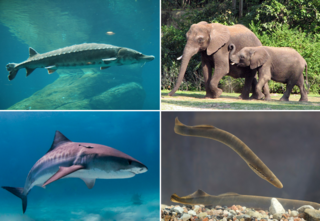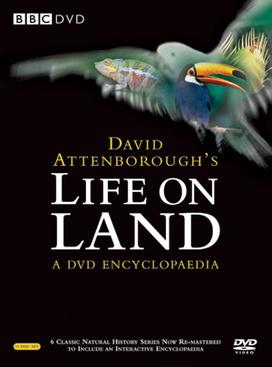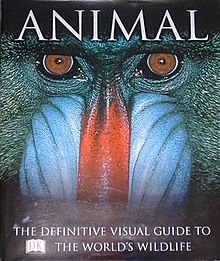
Reptiles, as commonly defined, are a group of tetrapods with an ectothermic ('cold-blooded') metabolism and amniotic development. Living reptiles comprise four orders: Testudines (turtles), Crocodilia (crocodilians), Squamata, and Rhynchocephalia. As of May 2023, about 12,000 living species of reptiles are listed in the Reptile Database. The study of the traditional reptile orders, customarily in combination with the study of modern amphibians, is called herpetology.

Vertebrates are deuterostomal animals with bony or cartilaginous axial endoskeleton — known as the vertebral column, spine or backbone — around and along the spinal cord, including all fish, amphibians, reptiles, birds and mammals. The vertebrates consist of all the taxa within the subphylum Vertebrata and represent the overwhelming majority of the phylum Chordata, with currently about 69,963 species described.

A tetrapod is any four-limbed vertebrate animal of the superclass Tetrapoda. Tetrapods include all extant and extinct amphibians and amniotes, with the latter in turn evolving into two major clades, the sauropsids and synapsids. Some tetrapods such as snakes, legless lizards, and caecilians had evolved to become limbless via mutations of the Hox gene, although some do still have a pair of vestigial spurs that are remnants of the hindlimbs.

Hibernation is a state of minimal activity and metabolic depression undergone by some animal species. Hibernation is a seasonal heterothermy characterized by low body-temperature, slow breathing and heart-rate, and low metabolic rate. It most commonly occurs during winter months.

Synapsids are one of the two major clades of vertebrate animals in the group Amniota, the other being the sauropsids. The synapsids were the dominant land animals in the late Paleozoic and early Mesozoic, but the only group that survived into the Cenozoic are mammals. Unlike other amniotes, synapsids have a single temporal fenestra, an opening low in the skull roof behind each eye orbit, leaving a bony arch beneath each; this accounts for their name. The distinctive temporal fenestra developed about 318 million years ago during the Late Carboniferous period, when synapsids and sauropsids diverged, but was subsequently merged with the orbit in early mammals.

A therapsid is a member of the clade Therapsida which is a major group of eupelycosaurian synapsids that includes mammals and their ancestors and relatives. Many of the traits today seen as unique to mammals had their origin within early therapsids, including limbs that were oriented more underneath the body, as opposed to the sprawling posture of many reptiles and salamanders.

Amniotes are tetrapod vertebrate animals belonging to the clade Amniota, a large group that comprises the vast majority of living terrestrial and semiaquatic vertebrates. Amniotes evolved from amphibian ancestors during the Carboniferous period and further diverged into two groups, namely the sauropsids and synapsids. They are distinguished from the other living tetrapod clade — the non-amniote lissamphibians — by the development of three extraembryonic membranes, thicker and keratinized skin, and costal respiration.

The nictitating membrane is a transparent or translucent third eyelid present in some animals that can be drawn across the eye from the medial canthus to protect and moisten it while maintaining vision. All Anura, and some reptiles, birds, and sharks have full nictitating membranes; in many mammals, a small, vestigial portion of the nictitating membrane remains in the corner of the eye. Some mammals, such as cats, beavers, polar bears, seals and aardvarks, have full nictitating membranes. Often called a third eyelid or haw, it may be referred to in scientific terminology as the plica semilunaris, membrana nictitans, or palpebra tertia.

Aquatic respiration is the process whereby an aquatic organism exchanges respiratory gases with water, obtaining oxygen from oxygen dissolved in water and excreting carbon dioxide and some other metabolic waste products into the water.

The Life of Mammals is a nature documentary series written and presented by David Attenborough, first transmitted in the United Kingdom from 20 November 2002.

An egg is an organic vessel grown by an animal to carry a possibly fertilized egg cell and to incubate from it an embryo within the egg until the embryo has become an animal fetus that can survive on its own, at which point the animal hatches.

Pelycosaur is an older term for basal or primitive Late Paleozoic synapsids, excluding the therapsids and their descendants. Previously, the term mammal-like reptile had been used, and pelycosaur was considered an order, but this is now thought to be incorrect, and seen as outdated.

A zookeeper, sometimes referred as animal keeper, is a person who manages zoo animals that are kept in captivity for conservation or to be displayed to the public. They are usually responsible for the feeding and daily care of the animals. As part of their routine, the zookeepers may clean the exhibits and report health problems. They may also be involved in scientific research or public education, such as conducting tours and answering questions.

Eupelycosauria is a large clade of animals characterized by the unique shape of their skull, encompassing all mammals and their closest extinct relatives. They first appeared 308 million years ago during the Early Pennsylvanian epoch, with the fossils of Echinerpeton and perhaps an even earlier genus, Protoclepsydrops, representing just one of the many stages in the evolution of mammals, in contrast to their earlier amniote ancestors.

Live food is living animals used as food for other carnivorous or omnivorous animals kept in captivity; in other words, small preys fed alive to larger predators kept either in a zoo or as a pet.
Tim Low is an Australian biologist and author of articles and books on nature and conservation. His seventh book, Where Song Began: Australia's Birds and How They Changed the World, became the first nature book ever to win the Australian Book Industry Awards prize for best General Non Fiction, in 2015. In the same year it was shortlisted for the NSW Premier's History Awards. An earlier book, Feral Future, inspired the formation of an NGO, the Invasive Species Council. His earlier books helped popularise Australian bush tucker. Four of his books have won national prizes.

Raymond Lee Ditmars was an American herpetologist, writer, public speaker and pioneering natural history filmmaker.

The history of paleontology traces the history of the effort to understand the history of life on Earth by studying the fossil record left behind by living organisms. Since it is concerned with understanding living organisms of the past, paleontology can be considered to be a field of biology, but its historical development has been closely tied to geology and the effort to understand the history of Earth itself.

David Attenborough's Life on Land: A DVD Encyclopaedia is a DVD box set of nature documentaries made by the BBC Natural History Unit. It comprises six series spread across 15 discs, all of them written and presented by David Attenborough, and together forming a comprehensive introduction to the major groups of terrestrial lifeforms. The series were filmed between 1987 and 2008, but are presented in the order in which the groups evolved, beginning with invertebrates and culminating with human beings, to tell the continuous story of the development of life on land. With a total running time exceeding 34 hours, it represents an in-depth visual survey of the living world as it exists today, at the beginning of the 21st century.
Philip John Lymbery is the Global CEO of farm animal welfare charity, Compassion in World Farming International, Visiting Professor at the University of Winchester’s Centre for Animal Welfare, President of Eurogroup for Animals, Brussels, founding Board member of the World Federation for Animals and a Leadership Fellow at St George's House, Windsor Castle.


















